AI is transforming risk management by automating tasks, ensuring compliance, and detecting fraud across industries like healthcare, finance, and manufacturing. This article highlights 10 AI tools designed to streamline risk assessment, compliance monitoring, and fraud prevention. Here's a quick overview:
- Centraleyes: Multi-industry tool with AI-powered risk mapping and real-time threat monitoring.
- Compliance.ai: Tracks regulatory updates and aligns them with internal policies.
- Kount: Detects fraud in real-time for e-commerce and finance.
- SAS Compliance Solutions: Advanced analytics for fraud detection and compliance.
- S&P Global: Offers data-driven insights and regulatory updates.
- IBM Watson: Uses cognitive AI for compliance automation.
- AuditBoard: Simplifies workflows with AI-powered compliance tools.
- RiskWatch: Customizable frameworks for risk assessments.
- CyberGRX: Focuses on third-party risk management.
- Quantifind: Reduces false positives in risk detection using NLP.
Quick Comparison
| Tool Name | Key Industries | Features | Ideal For |
|---|---|---|---|
| Centraleyes | Finance, Healthcare | AI risk mapping, real-time threats | Large enterprises |
| Compliance.ai | Cross-industry | Regulatory tracking, dashboards | Regulatory-focused organizations |
| Kount | E-commerce, Finance | Fraud detection, compliance checks | Online businesses |
| SAS Compliance | Banking, Retail | Analytics, fraud detection | Large firms with IT teams |
| S&P Global | Finance, Energy | Data insights, compliance tracking | Enterprises |
| IBM Watson | Multiple industries | Workflow automation, AI insights | Large corporations |
| AuditBoard | Finance, Healthcare | Compliance automation, risk tools | Mid to large companies |
| RiskWatch | General use | Custom frameworks, risk tracking | Basic risk evaluations |
| CyberGRX | Technology, Cybersecurity | Third-party risk management | Companies with vendor exposure |
| Quantifind | Finance, Retail | NLP, predictive analytics | Data-driven organizations |
These tools help organizations improve accuracy, reduce manual tasks, and stay compliant. Read on to explore how each tool works and fits various industries.
Predict360 - AI Powered Risk and Compliance Management Software
1. Centraleyes: Risk Management for Multiple Industries
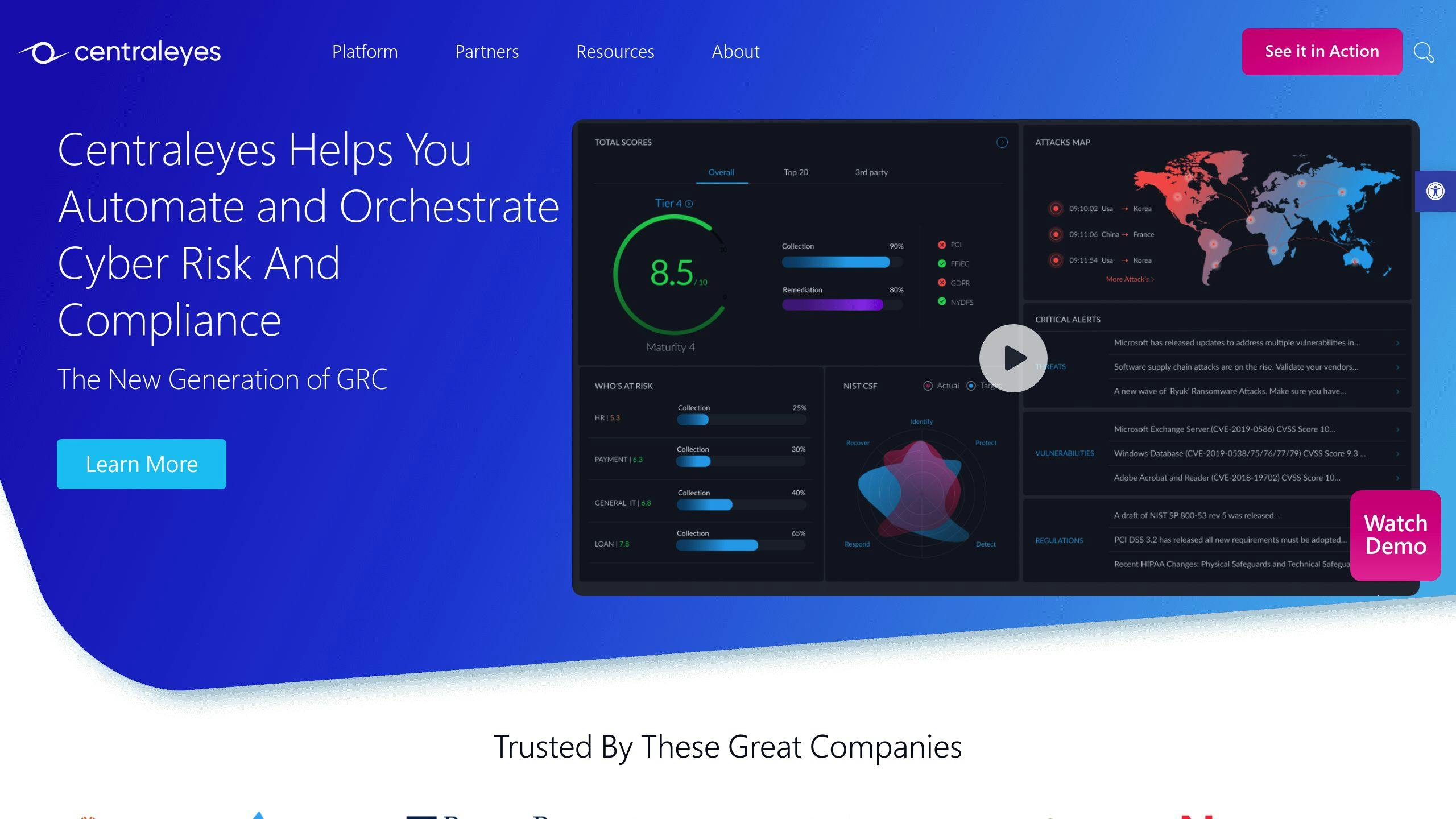
Centraleyes is a cloud-based platform designed to simplify risk management with the help of AI. It caters to industries like banking, healthcare, retail, manufacturing, and energy, each with its own set of compliance and regulatory requirements.
One standout feature of Centraleyes is its AI-powered risk register. This tool automatically maps risks to industry standards, saving time and improving precision by cutting out manual research. It's particularly helpful in complex scenarios like mergers and acquisitions, where the platform gathers and organizes data to classify threats, ensuring that decisions are both informed and compliant.
"Resilience and risk management is ultimately a data-driven discipline. The more relevant information you can aggregate about your business's ecosystem, the more accurate your unique risk profile becomes." - Yair Solow, CEO at Centraleyes [2]
Centraleyes also integrates with tools like JIRA and ServiceNow, making it easier to manage workflows and follow up on remediation tasks. The platform stays current with the latest frameworks and threats specific to different industries, offering features like:
- Real-time threat monitoring and automated analysis
- Pre-built assessments tailored to various sectors
- Integration with ITSM tools for smoother operations
- Actionable insights for compliance and performance tracking
2. Compliance.ai: Regulatory Risk Management
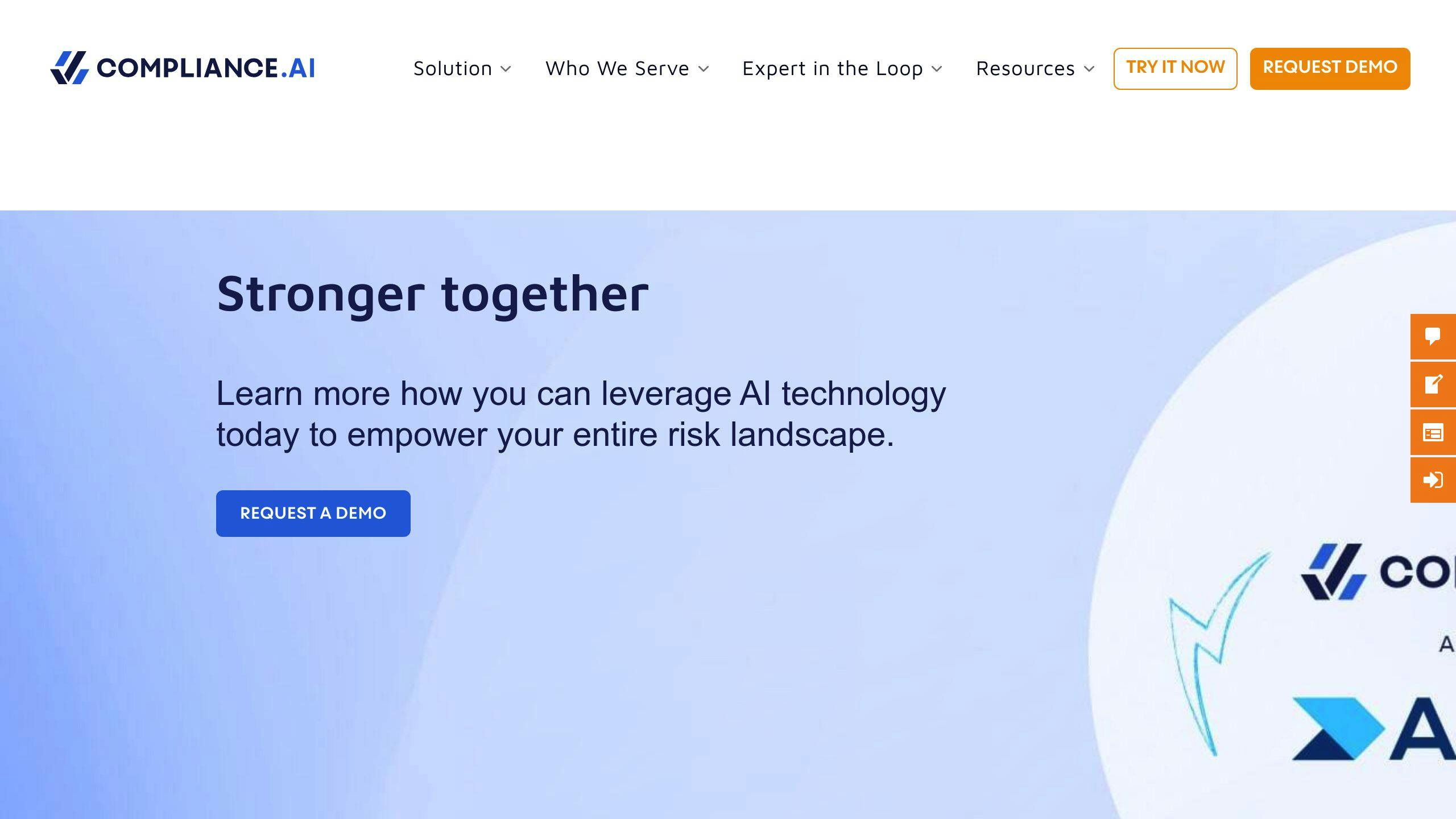
Compliance.ai, now part of Archer, leverages advanced machine learning to keep tabs on regulatory updates in real-time. It connects these changes directly to an organization’s internal policies and procedures. Unlike general risk management tools, Compliance.ai focuses solely on regulatory compliance, making it a go-to solution for industries like financial services, healthcare, and technology that face intricate regulatory demands.
The platform offers personalized dashboards and smart workflows that deliver tailored risk alerts and compliance updates. Its AI engine processes and organizes regulatory data, ensuring decision-makers can access the information they need without delay.
Compliance.ai’s integrations streamline operations by combining regulatory tracking, automating workflows, and improving reporting. Industry-specific solutions - like monitoring banking regulations or ensuring HIPAA compliance - analyze regulatory changes so teams can address potential risks before they become major issues.
"The integration of AI not only enhances operational efficiency but also strengthens regulatory compliance by providing real-time insights and actionable intelligence to compliance, risk, and legal teams" [1]
By analyzing regulatory changes and aligning internal policies in real-time, the platform helps organizations stay ahead of compliance challenges. Its targeted updates save time and simplify risk management, allowing businesses to stay compliant without unnecessary hassle.
As regulatory environments become more intricate, tools like Compliance.ai are raising the bar for risk management. Up next, we’ll dive into Kount, a leader in fraud prevention and risk analysis.
3. Kount: Fraud Prevention and Risk Analysis
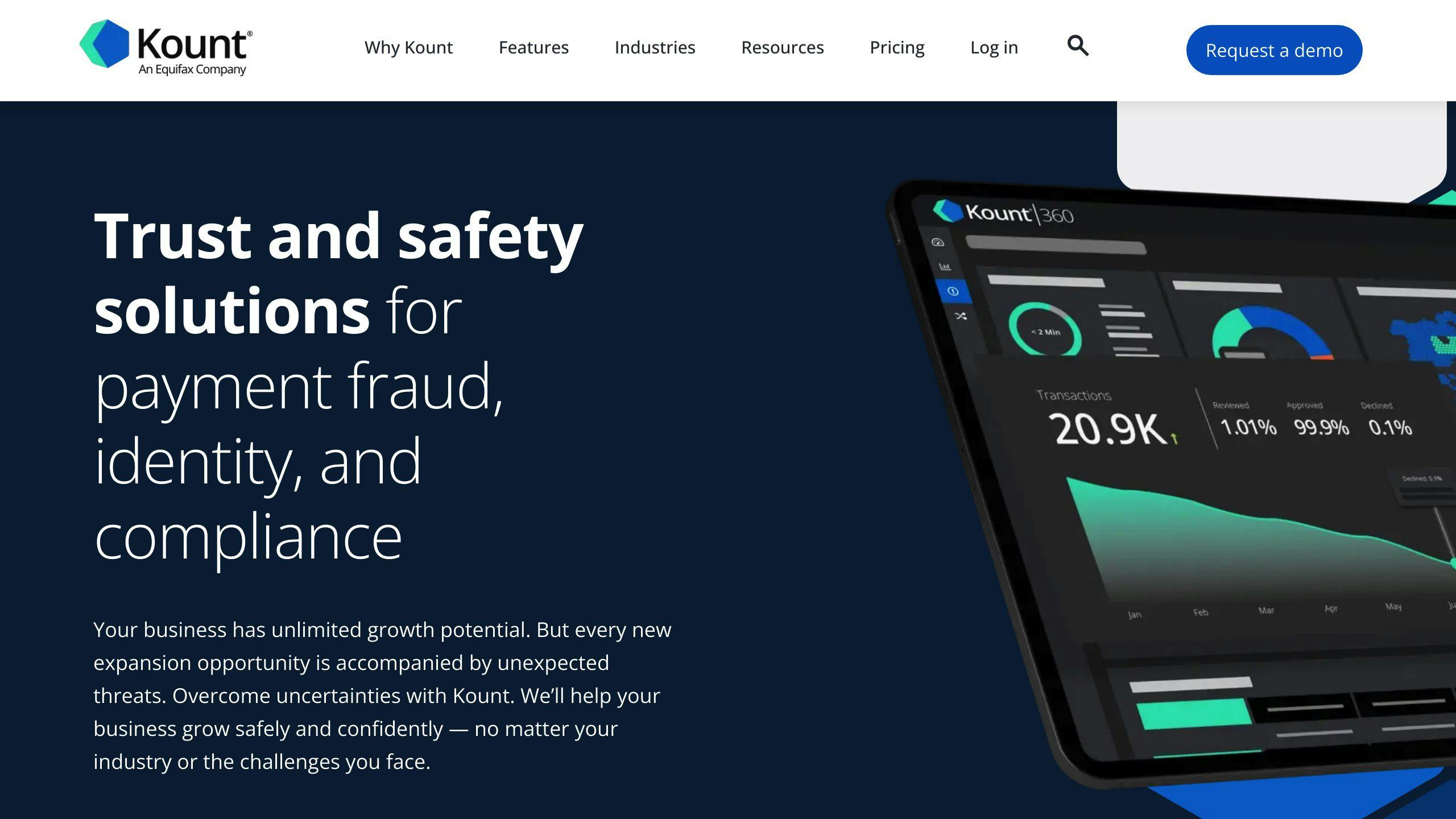
Kount, now part of Equifax, is an AI-powered platform designed to tackle fraud and manage risks in industries like e-commerce, finance, and healthcare. By analyzing data patterns, Kount identifies fraudulent activities in real-time, helping businesses stay protected from new threats while adhering to regulations.
At its core, Kount offers real-time screening against global watchlists, including sanctions and PEPs databases. This automated system minimizes manual effort while delivering high accuracy [1].
Here are some of Kount's standout features:
- Real-time Risk Assessment: Monitors continuously and sends instant alerts for suspicious activities.
- Automated Compliance Screening: Leverages Equifax's vast data resources to streamline identity and compliance checks.
- Industry-Specific Tools: Tailored solutions for combating e-commerce fraud, monitoring financial compliance, and safeguarding healthcare data.
Kount's AI learns and adapts from data patterns, ensuring fraud detection happens instantly during transactions. By combining Equifax's historical data with its own technology, Kount effectively identifies threats before they disrupt operations.
This focus on proactive fraud prevention leads us to the next tool, SAS Compliance Solutions, which uses advanced analytics for risk management.
4. SAS Compliance Solutions: Advanced Risk Tools
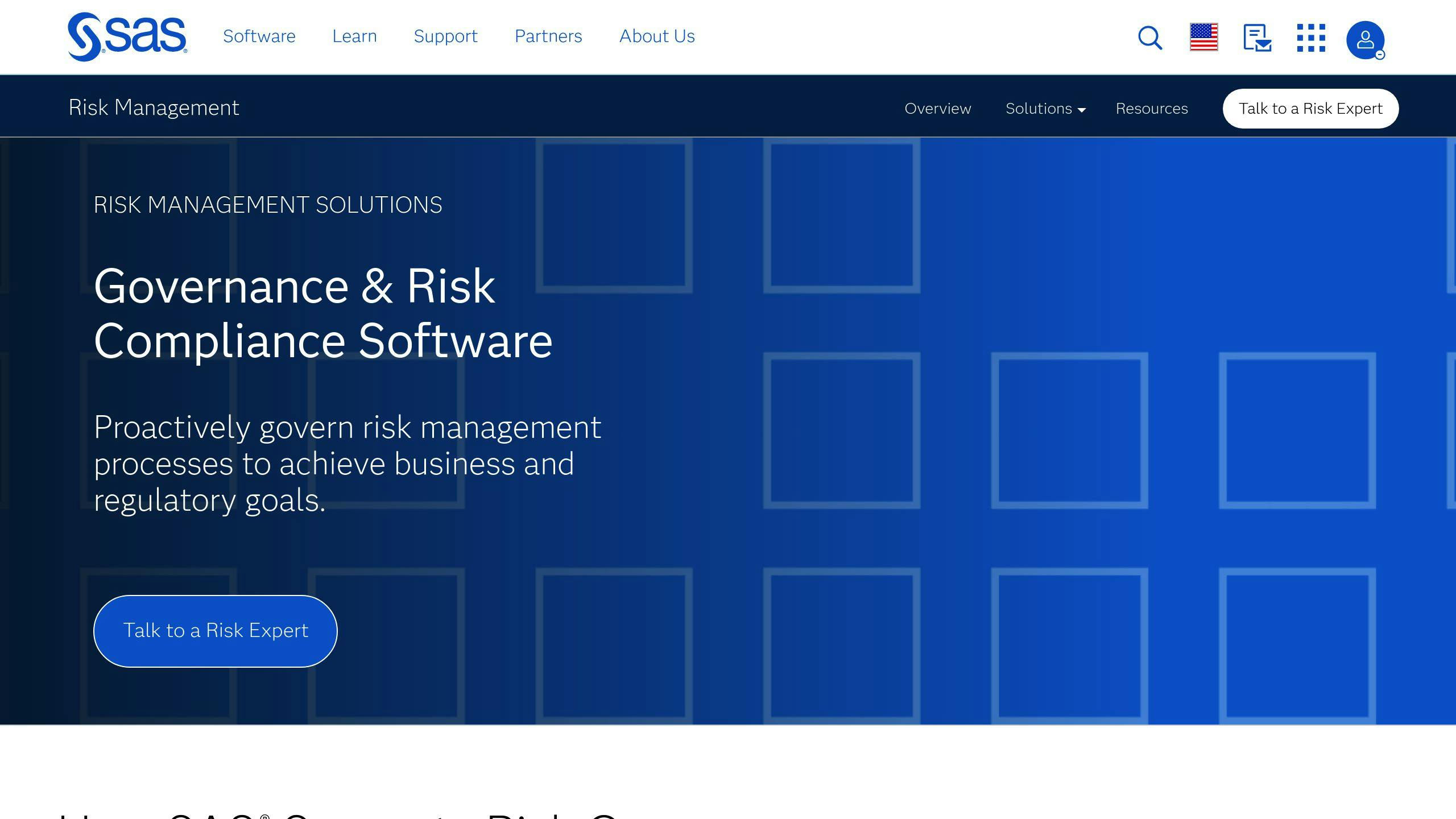
SAS Compliance Solutions leverages the SAS Viya platform to provide AI-driven analytics designed for managing risk. This platform ensures advanced analytics are available to users across industries such as finance, healthcare, government, and manufacturing.
By combining AI and machine learning, the platform excels in areas like fraud detection, regulatory reporting, and customer due diligence. Its tools are tailored to meet the unique challenges of specific industries, thanks to its sector-focused frameworks.
What makes SAS Compliance Solutions stand out is its integrated approach to risk management. Built on the SAS Viya architecture, it allows for real-time analysis of massive datasets [1]. This feature is especially useful for organizations navigating complex regulatory landscapes or handling large-scale risk assessments.
| Feature | Benefit |
|---|---|
| AI-Powered Analytics | Reduces false positives in fraud detection |
| Cloud-Native Architecture | Enables real-time compliance monitoring |
| Industry-Specific Tools | Delivers customized compliance solutions |
The platform’s real strength lies in its ability to keep up with evolving compliance demands while ensuring smooth operations. Its parallel processing and industry-specific tools make it a strong choice for businesses managing multiple compliance frameworks at once.
While SAS emphasizes AI-powered compliance and operational efficiency, S&P Global focuses on using data-driven insights to refine risk management strategies further.
5. S&P Global: Data-Driven Risk Insights
S&P Global's Essential Intelligence platform offers precise tools for compliance monitoring and risk management tailored to various industries. By processing structured data, it provides continuous regulatory updates that address specific industry needs. The platform's visualization tool, S&P Capital IQ Pro, simplifies complex risk assessments, making it easier for decision-makers to act.
S&P Global stands out by seamlessly integrating large datasets with existing systems, reducing disruptions while delivering actionable insights. Its real-time analysis turns complex information into clear guidance, helping sectors like finance and energy handle regulatory challenges effectively.
| Industry | Key Risk Management Features |
|---|---|
| Finance | Real-time regulatory monitoring, compliance tracking |
| Healthcare | Industry-specific risk analysis, regulatory updates |
| Energy | Environmental compliance, operational risk assessment |
The platform demonstrates how AI-powered tools can address industry-specific challenges, including regulatory compliance and operational risks. Its integration capabilities allow organizations to make use of AI-driven insights without overhauling their current workflows.
"S&P Global's AI tools have been recognized for their effectiveness in enhancing compliance management and risk assessment across various industries. Their solutions have helped numerous organizations improve their regulatory adherence and mitigate potential risks." [1]
While S&P Global focuses on data integration and visualization, IBM Watson takes a different approach by leveraging cognitive computing for risk management.
sbb-itb-bec6a7e
6. IBM Watson: AI for Risk and Compliance
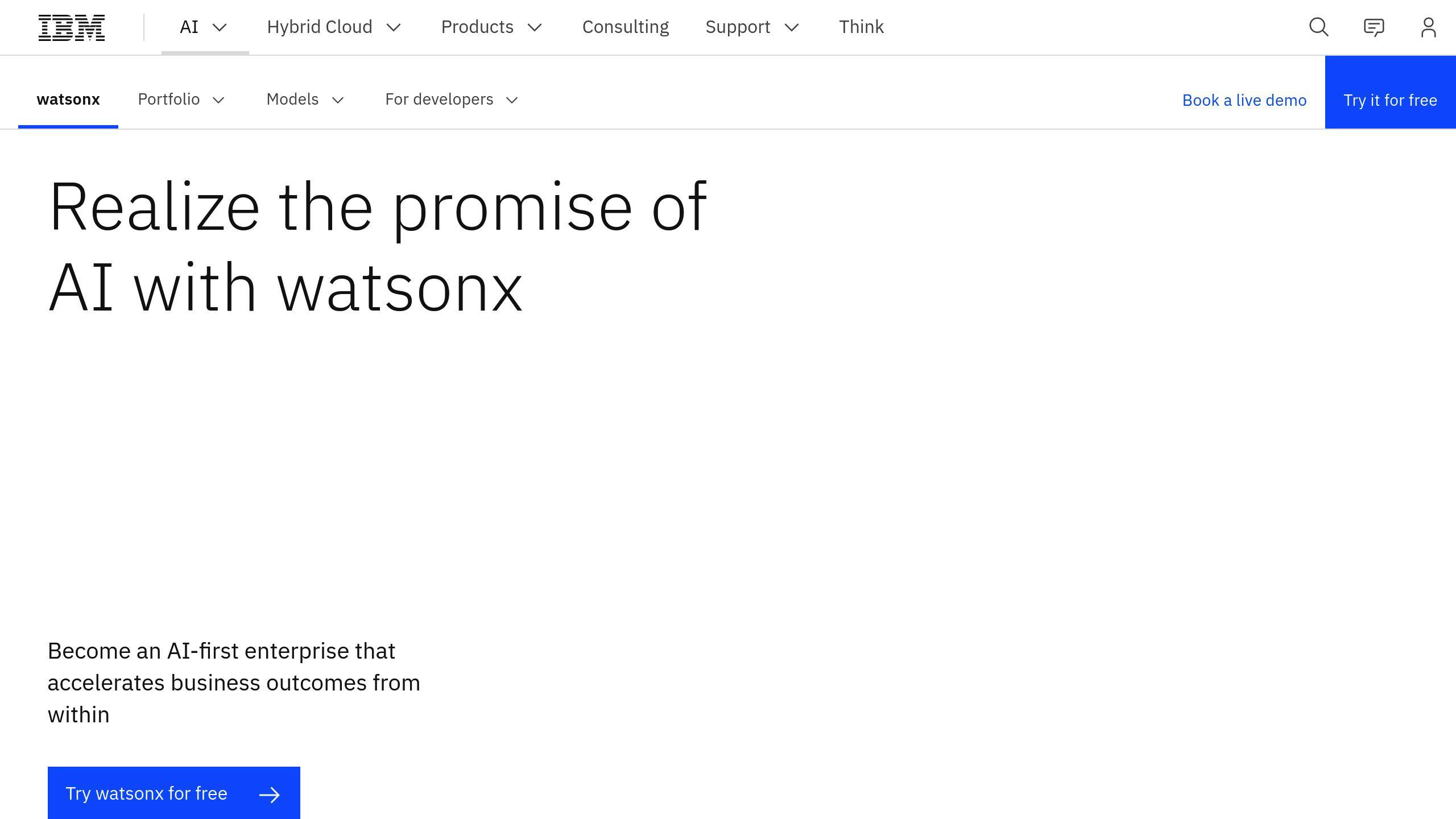
IBM Watson uses advanced AI to reshape how industries handle risk management and compliance. Its watsonx technology brings generative AI into the mix, making tasks like preparing risk assessments and audit summaries much easier.
With machine learning at its core, IBM Watson excels in areas such as:
- Spotting regulatory trends and identifying new risks
- Automating compliance reports and controls
- Offering actionable, data-based recommendations
The platform is designed to fit into existing systems without disrupting workflows, providing tailored solutions for specific industries.
| Industry | Risk Management Focus |
|---|---|
| Banking | Fraud detection and compliance tracking |
| Healthcare | HIPAA compliance and safeguarding data |
| Insurance | Claims review and fraud detection |
| Manufacturing | Safety protocols and operational risk |
IBM Watson prioritizes responsible AI practices, ensuring its tools meet the growing need for explainable compliance solutions. Its generative AI features are especially useful in regulated fields like banking and healthcare, where automating complex documentation is critical for maintaining accuracy.
By handling routine tasks - like writing control descriptions or risk statements - IBM Watson allows teams to concentrate on bigger-picture decisions while staying compliant with regulations.
While IBM Watson leans on automation and cognitive AI to simplify compliance, AuditBoard takes a different approach, focusing on aligning risk and compliance management with organizational workflows.
7. AuditBoard: Risk and Compliance Management
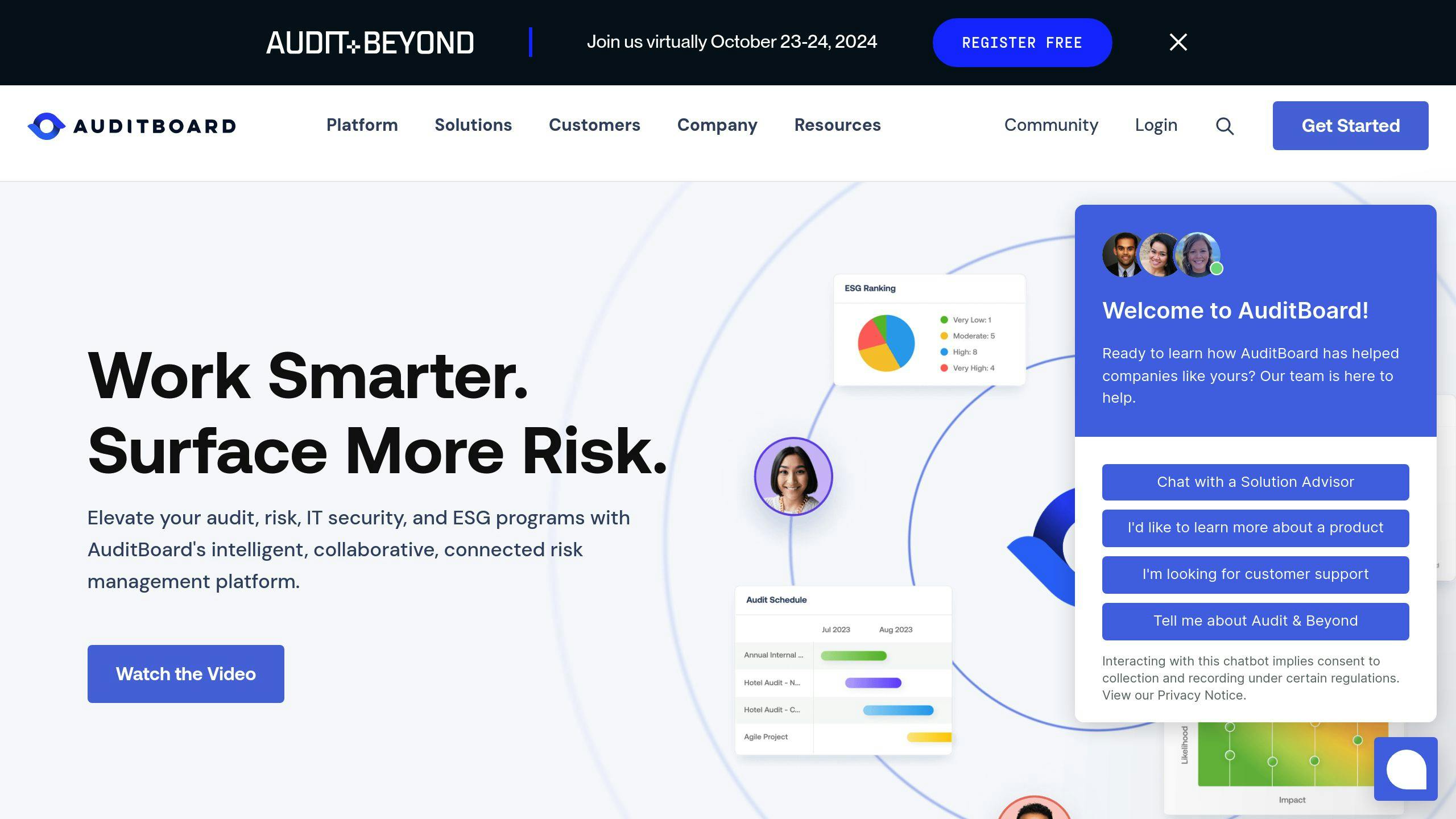
AuditBoard uses AI to simplify risk and compliance tasks, helping users create detailed documents like control descriptions and audit summaries. It also automates complex compliance workflows, saving time and effort.
With machine learning, the platform analyzes data to pinpoint risks, align regulatory frameworks with controls, and link compliance requirements to potential issues. This is particularly useful in industries like finance, healthcare, and manufacturing.
AuditBoard also provides real-time monitoring, allowing organizations to respond quickly to regulatory updates and address new risks effectively.
Here’s how its AI features support key functions:
| Function | AI-Driven Capability |
|---|---|
| Fraud Detection | Identifies suspicious patterns using analytics |
| Regulatory Compliance | Automates documentation and reporting |
| Risk Assessment | Identifies and analyzes risks in real-time |
| Control Monitoring | Continuously evaluates the effectiveness of controls |
The platform’s intuitive design ensures that compliance officers and risk managers can use these tools without needing deep technical expertise.
By automating compliance tasks and embedding AI into every step, AuditBoard minimizes manual work, improves accuracy, and boosts efficiency.
While AuditBoard focuses on compliance automation, RiskWatch stands out with its tailored risk assessment solutions for specific industry needs.
8. RiskWatch: Risk Assessment Software
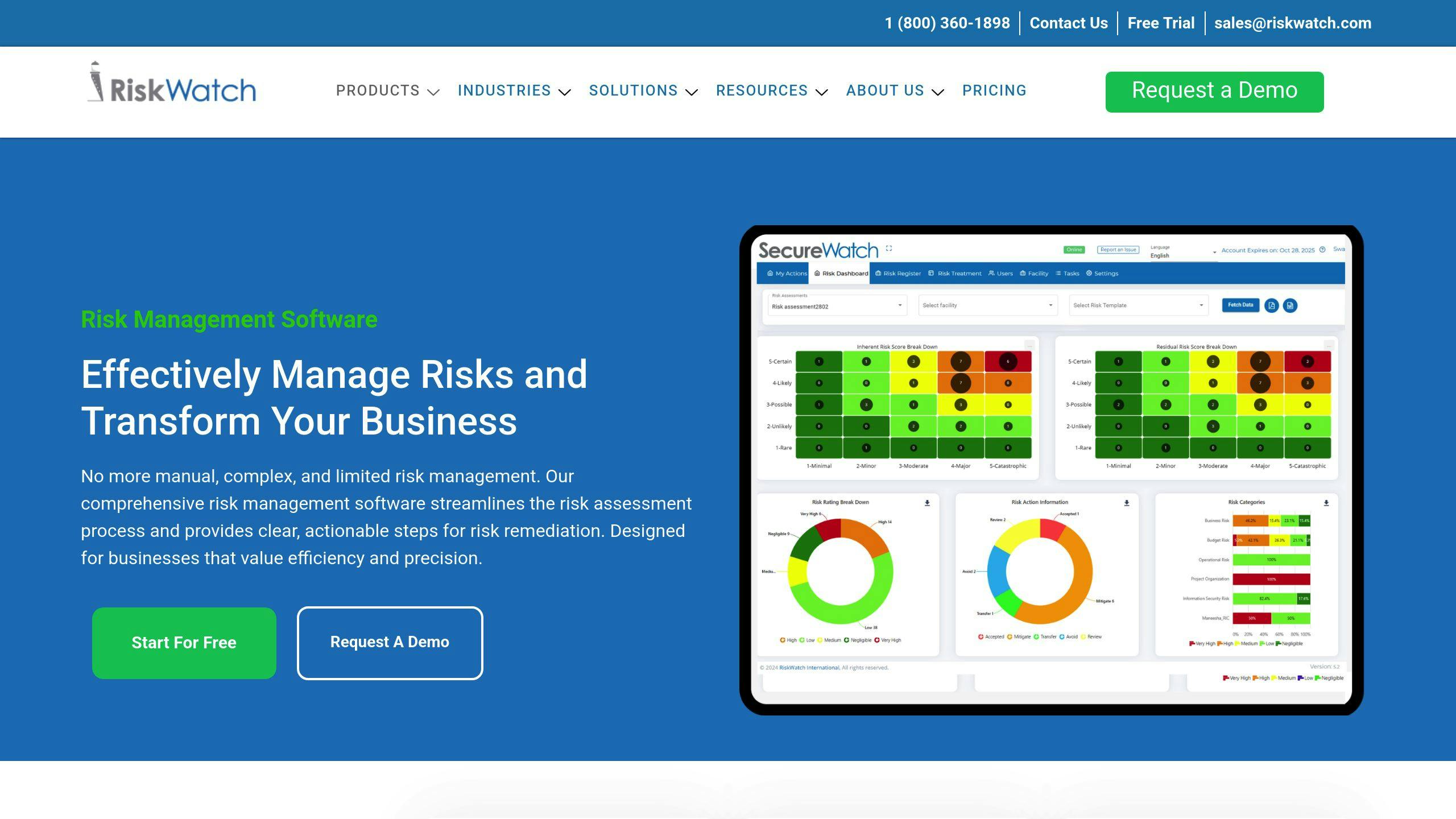
RiskWatch uses AI-driven tools to streamline risk assessment for businesses across various fields. It simplifies how risks are identified and evaluated, offering real-time insights to help organizations stay ahead of potential issues.
One of its standout features is its flexible risk frameworks, which can be tailored to meet the needs of specific industries. For example, financial institutions rely on RiskWatch to track regulatory compliance, while healthcare providers use it to safeguard patient data. Manufacturers also benefit from its ability to assess risks in supply chains.
Here’s a breakdown of what RiskWatch offers:
| Feature | What It Does | Who Uses It |
|---|---|---|
| Automated Assessment | Detects and analyzes risks in real time | Financial services, Healthcare |
| Compliance Tracking | Monitors regulatory requirements | Banking, Insurance |
| Risk Frameworks | Offers customizable templates | Manufacturing, Healthcare |
| Integration Tools | Connects with existing systems via APIs | All industries |
RiskWatch also prioritizes security, employing encryption, access controls, and compliance with data protection laws to ensure assessments remain secure. Its AI system is regularly updated to tackle emerging risks and new regulations, helping organizations stay prepared.
While RiskWatch focuses on real-time, proactive risk management, CyberGRX specializes in third-party risk management, offering a different approach to addressing vulnerabilities.
9. CyberGRX: Third-Party Risk Management
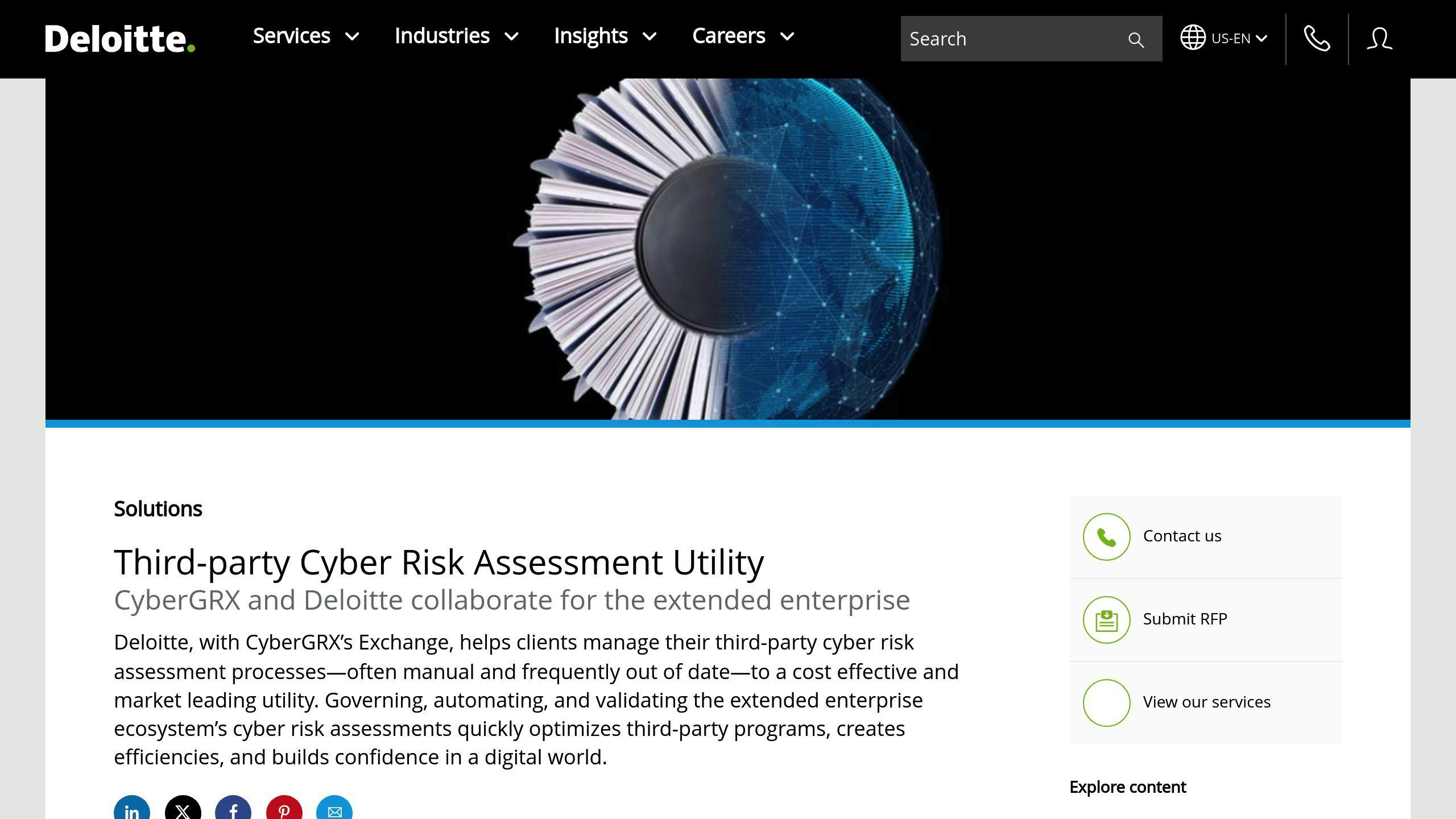
CyberGRX uses AI to reshape how companies manage third-party risks. Its AI-powered assessment engine evaluates and keeps track of risks tied to vendors, suppliers, and business partners in real-time. With predictive analytics, it spots potential issues before they arise, while continuous monitoring ensures quick action when threats occur.
| Industry | Focus Area | Features |
|---|---|---|
| Healthcare | Patient Data Protection | Helps meet HIPAA requirements |
| Finance | Service Provider Security | Tracks cybersecurity measures |
| Technology | Supply Chain Risk | Automates risk evaluations |
| Manufacturing | Vendor Performance | Monitors compliance |
"Third-party risk management is no longer a nice-to-have, but a must-have for organizations looking to protect their data and reputation." - Fred Kneip, CEO of CyberGRX [1]
CyberGRX works seamlessly with frameworks like NIST and ISO 27001, offering consistent risk management practices. Its AI-driven automation and centralized system make it possible to oversee thousands of vendors efficiently, fitting businesses of any scale.
One standout feature of CyberGRX is its sector-specific focus. The platform tailors its risk assessments to meet the distinct needs of various industries, delivering insights that align with specific compliance and security challenges. This customized approach highlights how AI can address the unique demands of each sector, making risk management more precise and actionable.
Up next, we'll dive into Quantifind, a tool designed for risk detection and analysis, offering specialized features for targeted industries.
10. Quantifind: Risk Detection and Analysis
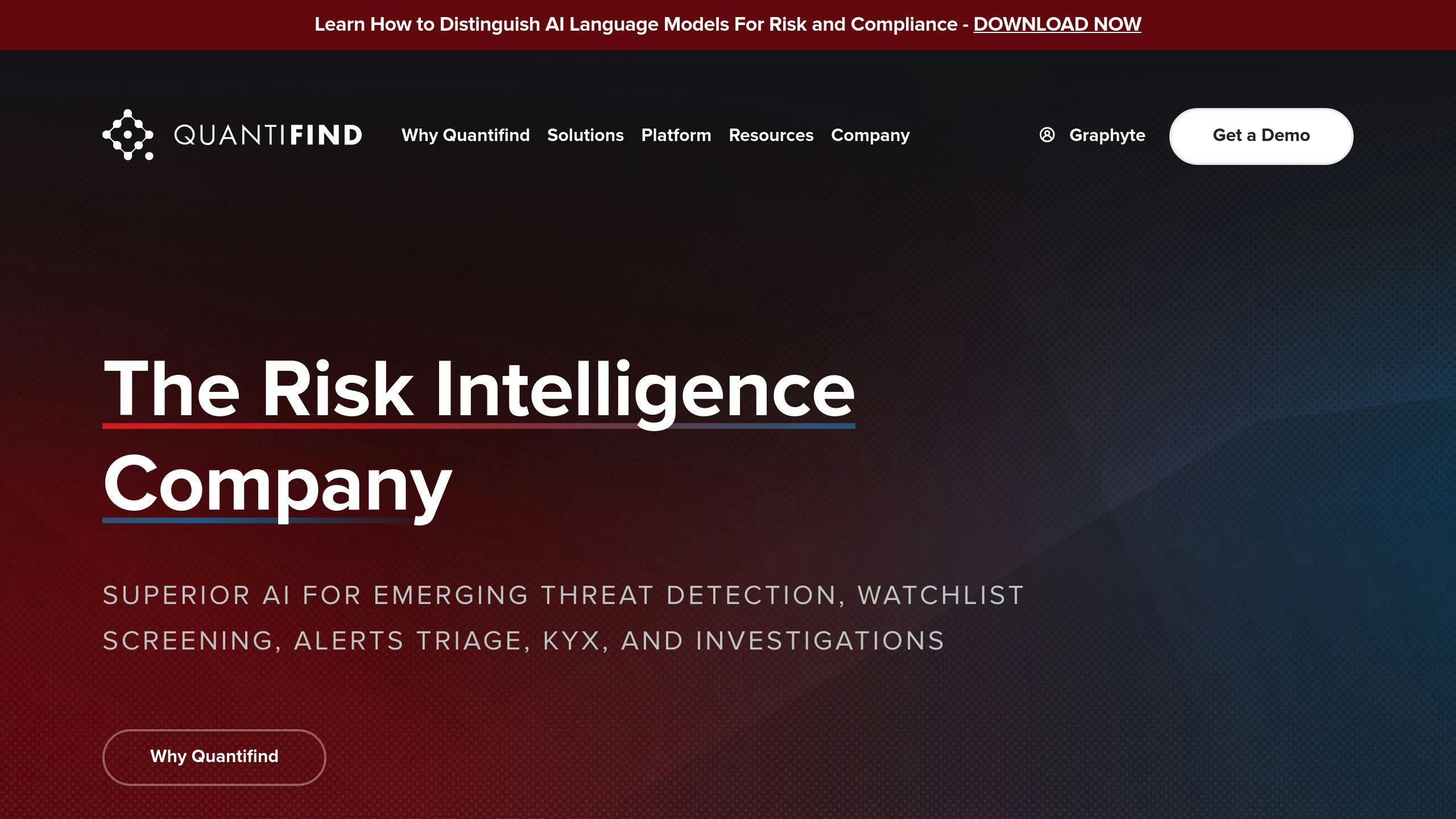
Quantifind uses AI-driven language analysis and machine learning to identify risks, uncover patterns, and cut down on false positives across various industries. Its Natural Language Processing (NLP) tools process large volumes of structured and unstructured data, offering a method that has decreased false positives by up to 90% while boosting detection accuracy by 80%.
| Industry | Key Features | Contribution to Operations |
|---|---|---|
| Financial Services | Enhanced AML/KYC processes with NLP | Lowered false positives in compliance checks |
| Healthcare | Automated HIPAA risk assessments | Better analysis of unstructured data |
| Retail | AI-driven transaction monitoring | Identifies patterns in customer behavior |
| Manufacturing | Supply chain risk analytics | Predictive assessments for vendor risks |
One notable feature is its automated compliance tracking system, which aligns with major regulatory frameworks. The platform updates its algorithms regularly to tackle new risks and regulatory changes, helping organizations stay compliant.
"Quantifind's tools have significantly reduced false positives in money laundering detection, enhancing compliance."
Quantifind integrates easily with existing risk management systems, offering a unified view of risks while simplifying compliance workflows. This ensures organizations can oversee risks effectively without disrupting their current processes.
The platform also tailors its solutions to specific industries, addressing unique challenges like financial compliance in banking or data protection in healthcare. By combining NLP with predictive analytics, Quantifind tackles common problems like inefficiencies caused by false positives, which often plague traditional risk assessment methods.
With its focus on advanced analytics and tailored solutions, Quantifind demonstrates how AI is reshaping risk management across different sectors.
Comparison Table of AI Risk Tools
The table below provides an overview of 10 AI-powered risk assessment tools, focusing on their key industries, features, and ideal use cases. This can help businesses choose tools that align with their specific challenges and goals.
| Tool Name | Primary Industries | Key Features | Advantages | Limitations | Best Suited For |
|---|---|---|---|---|---|
| Centraleyes | Finance, Healthcare, Technology | AI risk register, Automatic data aggregation | Better efficiency, Simplified compliance | Requires considerable setup | Large enterprises with complex compliance needs |
| Compliance.ai | Cross-industry | Regulatory monitoring, Personalized dashboards | Real-time updates, Better management | Challenging for non-experts | Companies focused on regulatory compliance |
| Kount | E-commerce, Financial Services | Advanced ML, Global watchlist screening | Strong fraud detection, Automated compliance | Higher costs | Medium to large online businesses |
| SAS Compliance Solutions | Banking, Insurance, Retail | Cloud-based analytics, Fraud detection | Increased efficiency, Accurate results | Needs technical expertise | Large firms with dedicated IT teams |
| S&P Global | Financial Services, Energy | Intelligence platform, Data insights | Broad risk insights, Smooth operations | High investment required | Enterprise-level organizations |
| IBM Watson | Multiple Industries | Automated workflows, Document generation | Workflow automation, Smart recommendations | Demands significant IT resources | Large corporations with robust IT budgets |
| AuditBoard | Finance, Healthcare | Workflow automation, Generative AI tools | Simplified compliance management | Steep learning curve | Mid to large-sized companies |
| RiskWatch | General Use | Customizable frameworks, Risk tools | Detailed assessments | Lacks industry-specific features | Organizations needing basic risk evaluations |
| CyberGRX | Technology, Cybersecurity | Continuous monitoring, AI-driven analysis | Improved cyber protection | Limited to cyber risks | Companies with third-party exposure |
| Quantifind | Financial Services, E-commerce | Predictive analytics, NLP tools | Advanced risk identification | Requires extensive data | Data-focused organizations |
Key Considerations When Choosing a Tool
When selecting a risk management tool, think about:
- How well it scales and integrates with your current systems
- Industry-specific compliance needs
- The technical skills available within your team
- Budget constraints and expected return on investment
If you're a smaller business or a growing company, platforms like AI for Businesses can offer tailored advice to help you pick tools that fit your operational needs.
The next section will explore how these tools are influencing risk management practices across various industries.
Conclusion
AI-powered tools have reshaped risk management by improving how risks are detected, compliance is monitored, and data is analyzed. Examples from various industries highlight how these tools are making a difference in tackling specific challenges.
When choosing an AI risk assessment tool, keep these important considerations in mind:
- How well it integrates with your current systems and team's expertise
- Whether it meets your industry's compliance standards
- Its ability to grow with your organization
- The overall cost and potential return on investment
Platforms like AI for Businesses can help organizations, especially smaller ones, identify the right tools to kickstart their risk management efforts. The first step is understanding your risk management goals and gradually expanding your capabilities as your organization grows.
The tools discussed here show how AI is changing the game for risk management, offering solutions tailored to unique needs. To implement them effectively, focus on ensuring high-quality data, regular system audits, and thorough performance checks. With the right approach and tools, organizations can strengthen their risk management processes and stay prepared for changing regulations and industry demands.


